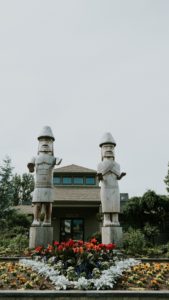Éy kw’es emí s’ólh temexws te Stó:lō
Welcome to our land of the Stó:lō
First and foremost, let me begin with an acknowledgment of territories where we have the honour and privilege to work, play and live on this land. As the writer of this website, I acknowledge that s’ólh temexw (our world or land) is the unceded and ancestral territories of the Stó:lō peoples.

Photograph Courtesy of Chilliwack Tourism
Stó:lō Welcome Figures at the Chilliwack Visitors Centre The Chilliwack Visitor’s Center is site two 18-foot tall welcome figures. Chief Siyameches Terry Horne, an Stó:lō artist, captures a traditional representation by the Stó:lō figures with raised hands in a gesture of welcome or to thank.
Kweleches in the Stó:lō’s Upriver Halq’eméylem language means greetings or welcome. Welcome, tothe website, Keeping the Promise: Remembering the Xwélmexw Greatness & Reflecting on the Settler Experience, is about the histories and stories from the Stó:lō people, through the eyes of a leader, William K’hhalseten Sepass.
Since the beginning of the twenty-first century, reconciliation in Canada has become a part of a growing discussion among Canadians, across the nation. We can ask ourselves the following questions: what does meaningful reconciliation mean? and what could this framework look like in our everyday lives? The Truth and Reconciliation Commission states “[t]he perspectives and understanding of Aboriginal Elders and Traditional Knowledge Keepers of the ethics, concepts, and practices of reconciliation are vital to long-term reconciliation (09)”.
At the heart of Canada’s path to reconciliation between mainstream Canada and Indigenous peoples, reconciliation cannot exist without mutual respect and an understanding from Canadians on the history of Canada with indigenous peoples. And above all, it must center on Indigenous people and histories, with the inclusion of Indigenous perspectives. It is pertinent to illuminate the stories and histories of Indigenous peoples; such as the lesser-known figures of the past; like K’hhalseten whose relationships with early settlers and efforts to challenge colonialism were overlooked.
References
National Centre for Truth and Reconciliation. Reconciliation as Relationship- pg. 15-17. Truth & Reconciliation – Calls to Action. P. 09.
Hauck, Jenna. “Terry Horne carves Sto:lo welcome figures for Chilliwack Visitor Centre,” Chilliwack Progress. June 16. 2017. https://www.theprogress.com/community/terry-horne-carves-stolo-welcome-figures-for-chilliwack-visitor-centre/. Accessed April 15, 2020.
Media Source
Tourism Chilliwack. December 2019.
Suggested Additional Readings
For more on the Halq’emeylem language:
https://www.firstvoices.com/explore/FV/sections/Data/Salish/Halkomelem/Halq’em%C3%A9ylem/learnFor more on unceded & First Nations terminology:
Vowel, Chelsea. 2016. In Indigenous Writes: A Guide to First Nations, Métis, and Inuit Issues in Canada. Winnipeg, Manitoba: HighWater Press.
For more on Stó:lō Artist, Chief Siyameches Terry Horne: Stó:lō Welcome Figures:
http://s3-us-west-2.amazonaws.com/tourismchilliwack/wp-content/uploads/2017/05/13112423/Stolo-Welcome-Figures-Press-Release.pdf
For more Stó:lō Stories through Cedar House Posts: visit, The Kidnapping of Stó:lō Boys During the Fraser River Gold Rush. http://loststories.ca/stolo/
For more on Reconciliation:
Truth and Reconciliation Commission of Canada. http://www.trc.ca/about-us/our-mandate.ht
Warry, Wayne. “Ending Denial- Understanding Aboriginal Issues”